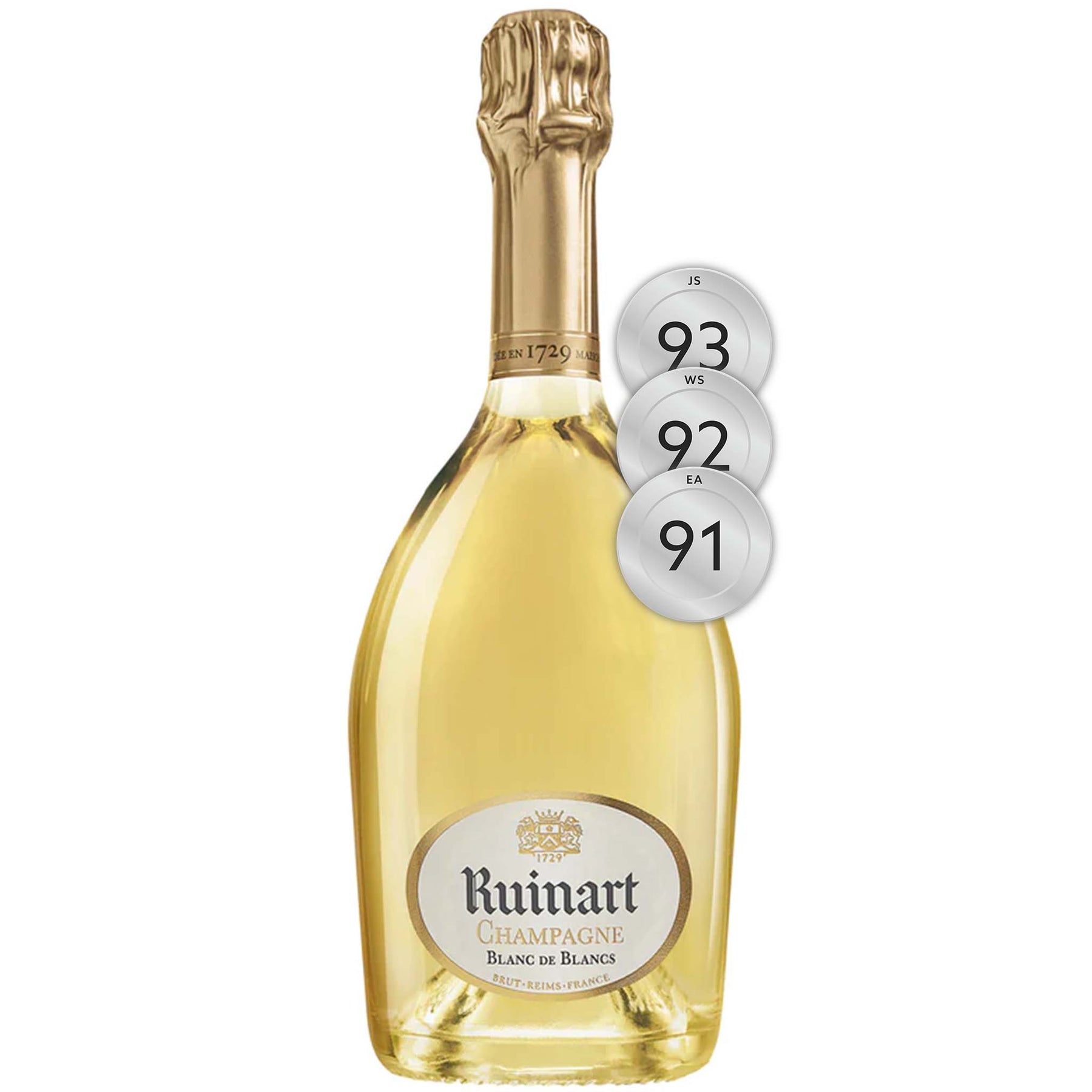
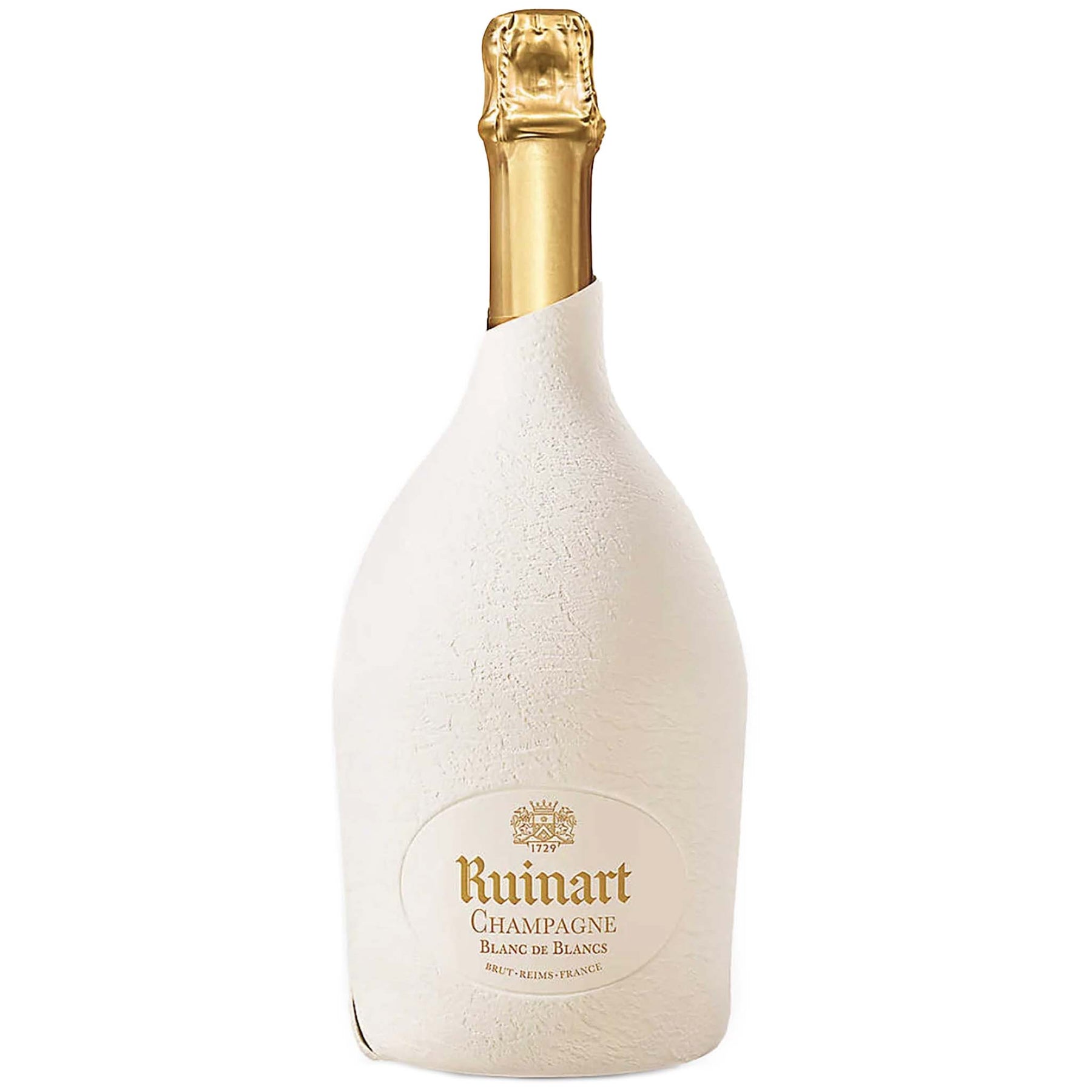
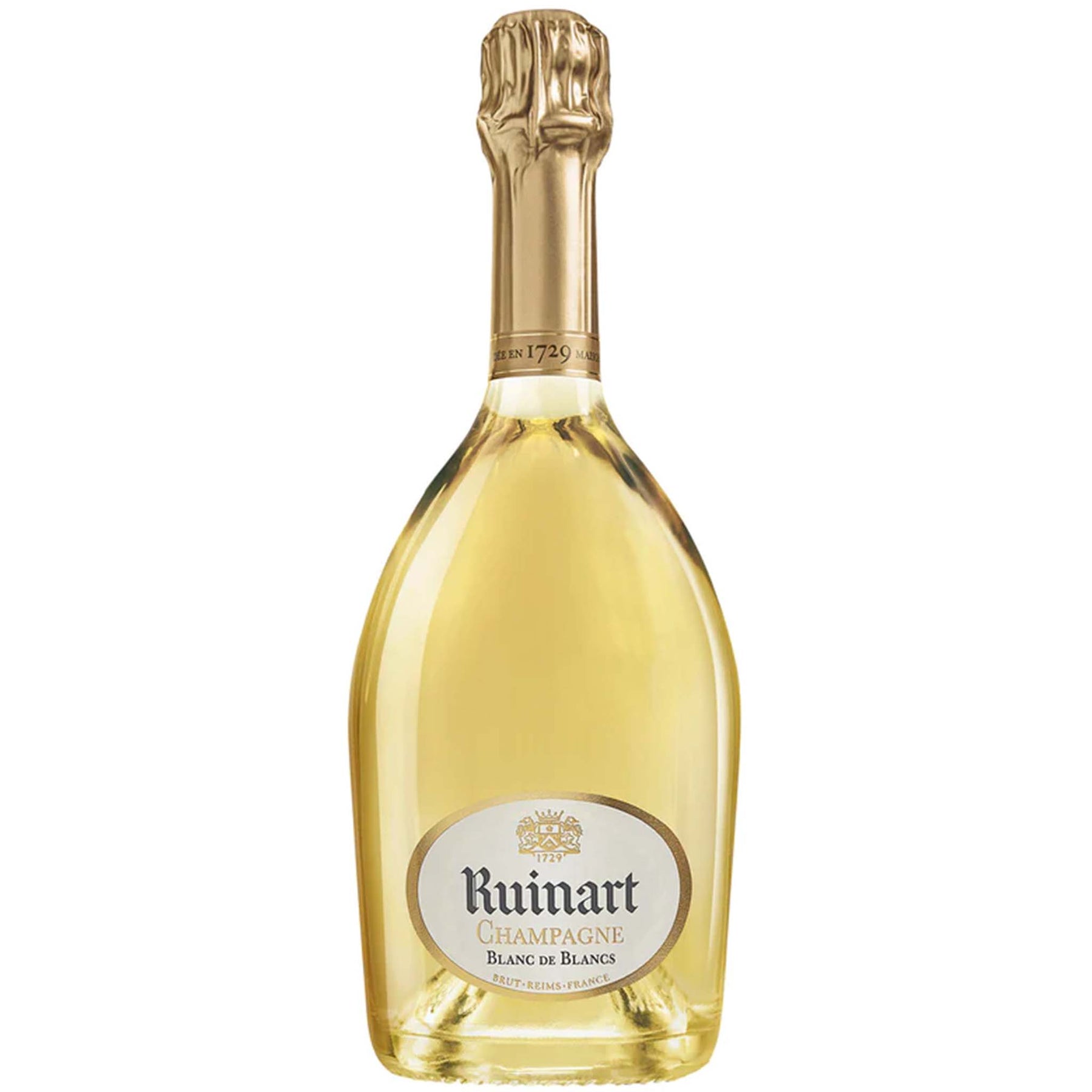
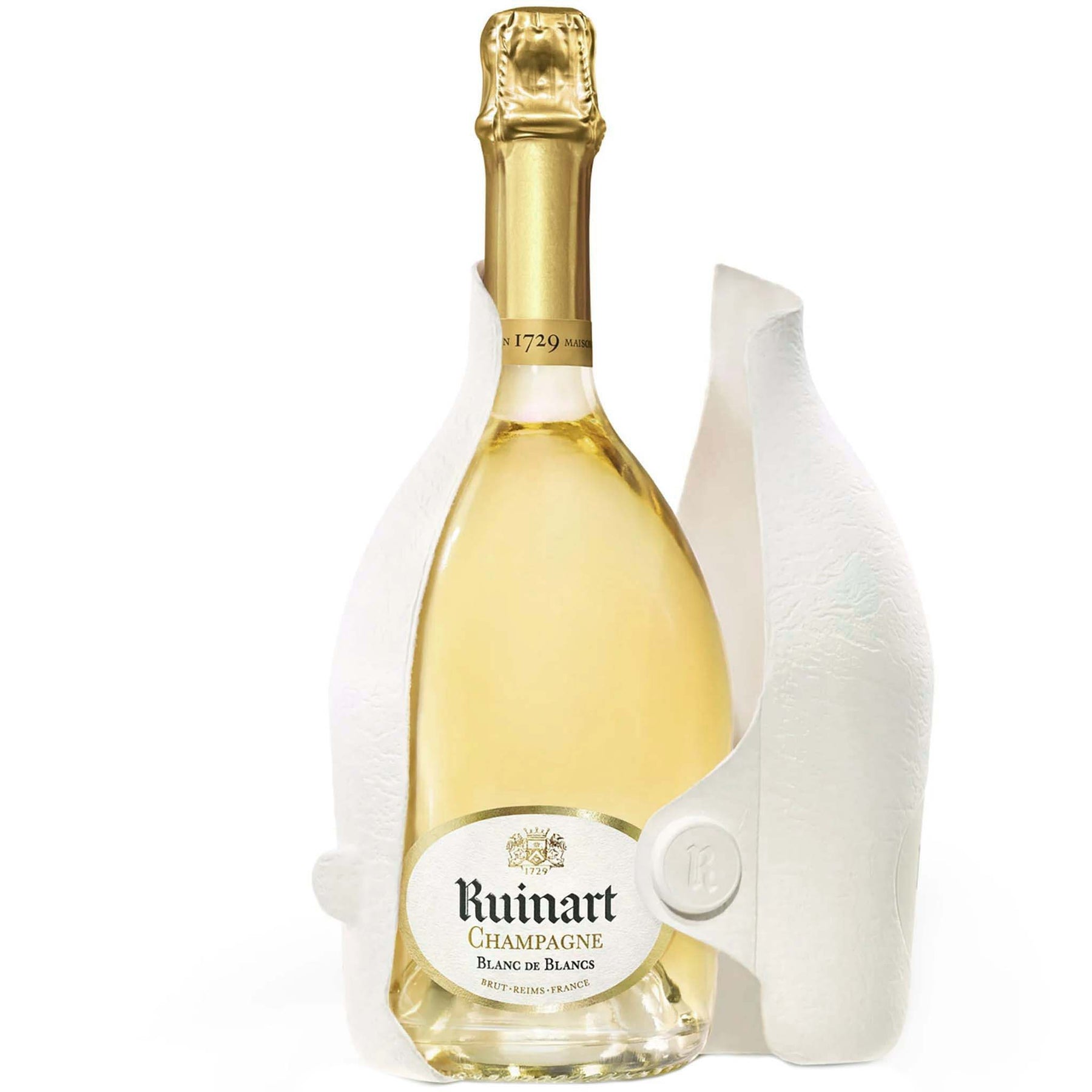
Ruinart Blanc de Blancs NV (Second Skin)
Style: Champagne Brut
Varieties: Chardonnay (100%)
Closure: Cork
Ruinart Blanc de Blancs NV (Second Skin)
Warehouse
34 Redland Drive
Vermont VIC 3133
Australia
Critic Score: 93
Alcohol: 12.5% Dosage: 7g/l
Size: 750 ml
Drink by: 2028
The Ruinart Blanc de Blancs NV reflects the rich diversity of Chardonnay grown in the Champagne region. It is made from Chardonnay sourced from Premier Cru vineyards in the Côte des Blancs and Montagne de Reims, blended with fruit from the slightly warmer Côte de Sézanne region which is some 40 kilometres to the south-west of the Côte des Blancs. The wine includes some 25–30 different chardonnay crus and comprises 20–30% reserve wine kept from a range of vintages. It is aged in the chalk cellars of Ruinart for 2-3 years before release. Dosage today is around 7g/l.
"The secret to the supple deliciousness of this blanc de blancs lies in its broad blend. The youthful nose is still very much on the primary fruit, with fine lemon and lime notes mixing with white flowers and green apple. The palate is super-fresh, but there is fruity suppleness to it, too. Lean, long and finishing on a pure fruity note. This one feels like it needs more time." Essi Avellan MW
"Visually, the Ruinart Blanc de Blancs has a brilliant robe with a beautiful pale yellow color and slight hints of almond green and jade green reflections. The first nose reveals intense aromas of fresh fruit: ripe lemon, juicy pear, or freshly picked peach. The secondary aromas are more floral with hints of white flowers, accompanied by a spicy touch combining ginger and pink peppercorns. Balancing tension with roundness, the enveloping structure is highlighted by fresh aromas of ripe citrus and tropical fruit. With a long and delicate finale." Ruinart
Expert reviews
"Brimming with pear, white peach and citrus fruit this enchanting Blanc de Blancs is so bright and succulent and is very hard to resist. I love the very long, silky and clean finish which has beautiful balance. Really fine mousse. Drink now. tasted Aug 2023." Stuart Pigott, JamesSuckling.com - 93 points
"A fresh, graceful Champagne marked by enticing aromas of elderflower and toasted almond. Offers a finely detailed mousse that carries flavors of white peach, Gala apple, grated ginger and preserved lemon, underscored by minerally hints of oyster shell and smoke that linger on the finish. Drink now through 2026. Tasted 2023." Alison Napjus, Wine Spectator - 92 points
"The secret to the supple deliciousness of this blanc de blancs lies in its broad blend, with Chardonnays from the Côte des Blancs and Montagne de Reims paired with softly fruity Vesle Valley and Sézannais grapes. Pale, greenish-yellow colour. The youthful nose is still very much on the primary fruit, with fine lemon and lime notes mixing with white flowers and green apple. Not much of Ruinart's hallmark smoky, toasty aromas surfacing yet. The palate is super-fresh, but there is fruity suppleness to it, too. Lean, long and finishing on a pure fruity note. This one feels like it needs more time. Drink: 2022-2028. Tasted Aug 2022." Essi Avellan MW – 91 points
Blanc de Blancs NV
 The flagship Dom Ruinart Blanc de Blancs is a blend of Chardonnay from Grand Cru vineyards primarily in the Côte des Blancs villages supplemented with a small amount from Montagne de Reims sites. In contrast, the non-vintage blend uses fruit from Premier Cru sites in the same locations, but also Chardonnay from the slightly warmer Côte de Sézanne region which is some 40 or so kilometres to the south-west of the Côte des Blancs. The wine includes some 25–30 different chardonnay crus and comprises 20–30% reserve wine kept from a range of vintages. It is aged in the chalk cellars of Ruinart for 2-3 years before release.
The flagship Dom Ruinart Blanc de Blancs is a blend of Chardonnay from Grand Cru vineyards primarily in the Côte des Blancs villages supplemented with a small amount from Montagne de Reims sites. In contrast, the non-vintage blend uses fruit from Premier Cru sites in the same locations, but also Chardonnay from the slightly warmer Côte de Sézanne region which is some 40 or so kilometres to the south-west of the Côte des Blancs. The wine includes some 25–30 different chardonnay crus and comprises 20–30% reserve wine kept from a range of vintages. It is aged in the chalk cellars of Ruinart for 2-3 years before release.
The popularity of the Ruinart Blanc de Blancs style has grown at an extraordinarily fast rate and now accounts for a quarter of Ruinart’s total volume. The main issue Chef de Cave Frédéric Panaïotis has is sourcing enough suitable Chardonnay in Champagne to keep pace with demand. The Sézannais Chardonnay has become increasingly important in the blend. It has a very expressive grapefruit zing to it, as well as some tropical fruit flavours and which Panaïotis describes as "perfect non-vintage blending material".
The style of this wine is very much fresh, clean and crisp, with a pure fruit character. The wine is made in a reductive style and can have the classic 'struck match' aroma. Today dosage is pretty much standard at around 7g/l. Panaïotis wants a certain fleshy, creamy character as that makes the wine very accessible. With a little bottle age tRuinart Blanc de Blancs NV develops a recognisable toastiness, plus more palate texture/mouthfeel and a longer finish.
Chef de Cave

Frédéric Panaïotis joined Champagne Ruinart in 2007 as Chef de Caves at the age of 43. His most important responsibility is to create the blends of champagne, from the non-vintages Blanc de Blancs and Rosé to the prestige cuvées of Dom Ruinart and Dom Ruinart Rosé.
Frédéric spent much of his childhood in the vineyards owned by his grandparents in the Montagne de Reims region of Champagne, discovering a world that later would become his true vocation. His professional career began with a training period in the Interprofessionnel Committee of Champagne, where he studied the method of making champagne. Frédéric continued his training at the Institut National Agronomique Paris-Grignon, specializing in Viticulture-Oenology followed by a degree in École Superieure d’Oenologie l’Montpellier.
Frédéric joined the LVMH stable where he spent more than 12 years as a winemaker at Veuve Clicquot learning his trade under cellar master Jacques Peters. In 2007, he transferred to the much smaller Ruinart, also under the LVMH umbrella, when the position of Chef de Cave became vacant. Having worked as a boy at his grandparent's small Chardonnay vineyard, it was appropriate that he ended up heading the winemaking of a house known especially for its Chardonnay champagnes. "A house of this size and quality level suits me perfectly," confesses Panaïotis.
Skilled cellar masters are Champagne’s celebrated stars. "I am not the star, the champagnes are the stars. We cellar masters spend most of our careers talking about the wines that our predecessors made. I am only the guardian of the style for the generations to come," says Frédéric Panaïotis in his characteristically modest and considerate way. During his tenure at the house, the wines have gained in precision and deservedly been awarded top prizes in prestigious wine competitions.
In addition to winemaking, the role of the cellar master in Champagne is increasingly one of communication. Today they are global ambassadors who zigzag the world to share their knowledge and promote their champagne House. Panaïotis has no difficulty being technical and entertaining at the same time. If you want to get technical, he is always eager to share his knowledge openly and constructively. Astonishingly, he can do this in at least eight different languages including Japanese and Mandarin Chinese! "I find that languages are a great tool for learning about cultures," Panaïotis explains. With his natural-sounding accents, it appears that languages are innate to him, but he insists it is all about hard work rather than a gift. "It is the same with tasting; I consider myself to be a reliable taster, but it is 95 per cent work and only five per cent talent."
When asked to tell something surprising about his role as Chef de Caves at Dom Ruinart, he replied, "As you may know, we collaborate every year with an artist, David Shrigley most recently. They spend time in our maison to learn about our history, our vineyards, our values and of course our wines. Then, they have carte blanche to create art pieces which will be displayed in contemporary art fairs worldwide. Every year, I find it fascinating to taste Ruinart cuvées with them. I explain our style and how we achieve it, starting from the grapes and through the winemaking process. I always love their approach, how they view things differently, often more deeply than us winemakers can. Art is an incredibly helpful tool to develop our emotional intelligence and elevate our souls."
The text below contains extracts from an interview with Frédéric Panaïotis in Selectus Wines Magazine in January 2021
We read somewhere that, to begin with, you wanted to work with animals... When and why did you change your mind?
"I wanted to be a vet, but basically this was because I wanted to work in a zoo. I wasn’t interested in working with cows or goats, but with tigers, lions ... I later realized that there were not many opportunities in this line of work, so I started studying biology because I wanted to be a scientist in this field, and this led to me to study agronomy. When I started on oenology, I fell in love with the discipline and stayed with it. And then, there was also the time when my uncle brought a bottle of Richebourg ’76 along to a Christmas dinner. I was really impressed by it and that was a real turning point. From that day on, I knew I wanted to work in the wine world."
Where did your story as an oenologist/winemaker start?
"My first work experience was in Roussillon in the south of France, then I was in Champagne, and after that, in Tain Hemitage and Califormia. In the end, I worked in Champagne for five years in 3 separate periods before I joined Ruinart. One of these work experiences was with the CIVC, the official Champagne interprofessional body, and this gave me a very broad perspective of the diversity of Champagne and its technical challenges."
What is your ambition at Ruinart?
"I intend to make a wine that reflects the philosophy and style of the Champagne House, respect its history and make wines that are more and more precise."
Do you have any current projects, either short, medium or long term?
"Our current plan is to celebrate the 300 year anniversary of the oldest Champagne House in Champagne, which is quite amazing! This will be in 2029 and we’re already working on a project to mark the occasion appropriately. Champagne has that magic, in that you can create things which will sometimes be enjoyed by future generations."
How many base wines do you work with? What is the oldest? And what is the oldest vintage in the Ruinart cellars?
"Between 200 and 250 different wines, the oldest is 3 years in the case of Ruinart and 12 years old for Dom Ruinart. The oldest vintage in our cellars is 1929. I’d like to take advantage of this interview to tell people that we are always on the lookout for old vintages and that we would be happy to recuperate any pre-1959 bottles of Ruinart as part of the Champagne House’s heritage."
About the winery

The history of this illustrious Champagne house, known internationally for the quality of its chardonnay grapes and the purity and aromatic finesse of its cuvées, spans nearly three centuries. Established in 1729 by Nicolas Ruinart, Maison Ruinart holds the title of the oldest established Champagne House in the region (Gosset, Founded in Aÿ in 1584, is the oldest wine estate).
The story begins with Nicolas Ruinart's uncle, Dom Thierry Ruinart, a visionary Benedictine monk who lived from 1657-1709. He was a brilliant theologian and historian, a friend and confidant of Dom Pérignon and a contemporary of Louis XIV. He left his home in Champagne at the age of 23 to go to the Abbey of Saint-Germain-des-Prés, one of the most influential centres of learning near Paris. It was here, exposed to the aristocratic courts and a more worldly life, that he learned of a new 'wine with bubbles' (not yet known as champagne) which was popular among young aristocrats.
Dom Ruinart encouraged his nephew Nicholas (1697-1769), a cloth merchant, to invest in this emerging market. Initially, Nicholas presented his most important cloth customers with champagne as a gift, but it was so well appreciated that when Louis XV declared that champagne could henceforth be sold in bottles instead of barrels, he heeded his uncle's advice and founded Champagne Ruinart. In 1730, Nicolas launched his Champagne onto the European market, by 1761 he was selling 36,000 bottles per year.
Nicholas was supported in this by his son Claude Ruinart (1731-1798) and the company name was expanded to Ruinart Père et Fils. After his father's death, Claude moved the company's headquarters from Epernay to Reims and expanded the champagne trade.
Many members of the Ruinart family (which officially became 'Ruinart de Brimont' in 1817) diligently guided the House during the two following centuries. With each passing generation, a new Head of House emerges, bringing forth their unique talents and unwavering commitment to serve the lineage of Ruinart. This steadfast succession ensures the preservation of the family's legacy, as each successor devotes themselves to upholding the traditions and values that define Ruinart. Their collective efforts propelled the House to unparalleled heights, solidifying its reputation as a bastion of excellence in the world of champagne.
Sadly, the Ruinart family’s reign came to an end in the 1950s following financial difficulties. The business accepted financial assistance from Baron Philippe de Rothschild, and in 1963 it was sold to Moet & Chandon, which subsequently became part of luxury goods group LVMH. Today the business is overseen by Frederic Dufour, a man well-versed in Champagne having held senior roles with Veuve Clicquot, Moet & Chandon and Moet Hennessy.
Although owned by LVMH, Ruinart still retains a high level of independence and its own style, nurtured by the talented Chef de Cave Frédéric Panaïotis who joined Champagne Ruinart in 2007. The unique shape of its bottle is a tribute to the historic bottles of the eighteenth century but Ruinart continues to build on its reputation for innovation and actively pushes the boundaries today. Ruinart was the first house dedicated to the production of champagne, the first house to ship Rosé champagne in 1764; the first house to use wooden cases and the first house to age their wine in 'Crayères'. They continue to focus on innovation and a commitment to sustainability, recent examples being the introduction In 2020 of the 'Second Skin' case as an alternative to the gift box and the reintroduction of ageing in cork instead of the metal crown cap that is widely used across Champagne. They are always looking to the future, at how they can stay ahead and how they can continue to be an industry leader.
With the House due to celebrate its 300th birthday in 2029, there are plans to create an extra special wine. For the time being, the plans are a closely guarded secret.; "Our chef de cave is preparing something pretty major for 2029. I don’t know the details," says Ruinart's U.S. brand director, Nicolas Ricroque.
Vineyards
Ruinart's own vineyards, which cover 20 hectares, are located primarily in the Montage de Reims. No herbicides are used and all vineyards belonging to Ruinart itself have been certified sustainable since 2014. 'Viticulture durable en Champagne' is the name of the label and was initiated by the Comité Champagne.
Ruinart also buys grapes from the Côtes des Blancs, Montage de Reims and the Côte de Sézanne. The House motivates and supports its grape suppliers to produce their vineyards according to the principles of the label and pay more for the grapes from sustainably managed vineyards.
Cover crop flowering and useful plants are now being extensively used in its vineyards. In its Taissy vineyard, Ruinart has initiated an ambitious reforestation project and will plant nearly 25,000 trees and shrubs to regenerate the soil and bring back the original fauna and flora to the parcel.
Winemaking
Frederic Panaïotis has slowly been pushing a reductive style of winemaking since he took over in 2007. "We hate oxygen!" he declares. Ruinart uses a pneumatic press to guard the juice against oxidation and uses inert nitrogen gas to protect the wine at every production stage.
Vinification only takes place in stainless steel and no oak is used. Long ageing in the crayères brings autolytic layers and the dosage has been reduced to low levels to retain freshness and to give the wines a certain flintiness.
Rosé Milestone
In 1764, the House achieved yet another milestone by successfully shipping the first-ever Rosé champagne across the vast expanse of Europe. This ground-breaking achievement introduced a new dimension to the world of champagne, captivating connoisseurs with its unique hues and flavours.
The Famous Crayères
As the sparkling wine business expanded, so too did the need for cellars. In 1768, Claude Ruinart, Nicolas' son, purchased eight kilometers of the Gallo-Roman chalk quarries (crayères) meticulously dug out beneath the historic city of Reims. The Ruinart crayères are a labyrinth of chalk chambers sometimes up to 38 meters deep, which became a French historic monument in 1931. These extraordinary caverns served as the ideal sanctuary for storing their precious bottles, ensuring optimal aging and maturation.
Unfortunately, there are no bottles pre-dating 1945 in the chalk cellars as the Germans found their way into the cellars during the war and basically emptied them.

The 'Second Skin' Case
In 2020, Ruinart revolutionised its packaging with the new 'Second Skin' case, an alternative to the gift box. Over three years of research and development were needed to produce the 'Second Skin', which is a 99% paper and recyclable case, moulded to the shape of the bottle. This case is 9 times lighter than its gift box predecessor and is produced without incurring any airfreight, resulting in a 60% reduction in its carbon impact.
Velvety soft to the touch and white like chalk, the case has a silky, organic feel and the surface of the second skin evokes the walls of the crayères where the bottles are aged. It protects the wines from light as well, which is essential for optimal storage, especially for the clear glass Ruinart Blanc de Blancs bottle. Suitable for storage for several months in a fridge, the case can withstand the humidity of a cellar, and up to three hours in an ice bucket. So rather than being disposed of immediately, the case may be retained until serving or longer to maintain the integrity of the wine.
Eco-designed from start to finish, it is nine times lighter than the previous generation of Ruinart gift boxes (just 40 grams, compared with 360 grams previously). The carbon footprint has been reduced by 60%, and 100% of the paper comes from sustainably managed European forests. What’s more, 91% of the water used in its production is clean enough to be released back into nature after filtering. Maison Ruinart President Frédéric Dufour says the new packaging marks a decisive stage in the Champagne house’s holistic environmental approach.
The reintroduction of ageing in cork
The champagnes that are stored for longer than six to seven years are now sealed with natural corks for bottle fermentation. Dom Ruinart Blanc de Blancs, Ruinart’s prestige cuvée, is renowned for its ability to age. It is fair to say that the decision to enact a fundamental change to the process by which the wine slowly matures on its lees in those famous crayères was not made in haste.
The newly released Dom Ruinart 2010 represents both a revolution and an evolution, a turning point that also sees the turning back of the clock. The vintage marks the first time in more than 50 years that it has been aged entirely under a cork stopper rather than the metal crown cap that is widely used across Champagne.
The latter has long been assumed to be the perfect closure for ageing Champagne prior to release. But almost a quarter of a century ago, in 1998, Ruinart initiated an experiment, with a select number of bottles sealed under cork and the remainder under crown cap, so that comparisons could be drawn. The experiment showed that the resulting minimal oxygen contact is very positive
"I was absolutely blown away by the differences revealed by the experiment, but it took me a while to understand why the cork had such an impact on the ageing process. Then I needed to convince the entire team, because making a significant change of this nature obviously required investment," said cellar master Frédéric Panaïotis. "In 2009 [the previous Dom Ruinart Blanc de Blancs release], we were simply not ready to make the change. But when it came to 2010, we felt we had done enough work to be convinced that it was the right decision. So the entire vintage went under cork – and now we can enjoy the result."
Collaboration with the Arts
The Champagne House's longstanding relationship with the arts made headlines in 1895 when André Ruinart commissioned famous Czech artist Alfons Mucha to create an advertising poster for its champagne.
Ever since Ruinart has sought out eclectic artists to create dedicated works of art. The work is then taken as the theme for the prestige cuvée presentation boxes. Perhaps the most famous example is "Bouquet de Champagne Dom Ruinart," pictured below. Created from Murano glass by Dutch artist Maarten Baas, it depicts a crystal chandelier that has plummeted onto a dining table.
 'Bouquet de Champagne Dom Ruinart' by Dutch artist Maarten Baas
'Bouquet de Champagne Dom Ruinart' by Dutch artist Maarten Baas
The Road Ahead
"We are very strong in France – that is how the house reestablished itself. Many people do not know that the house almost went bankrupt in 1946. There was no money and we had two customers – imagine that, only two customers, and one of them was not paying the bills. We were producing a total of 10,000 bottles, and the brand nearly disappeared. The person who was overseeing the brand at the time, who was 26 years old, knew that the focus needed to be on the French market, so we sold our wines in France," reflects Frédéric Panaïotis.
"When I joined the company over 16 years ago, 75 percent of our wines were sold in France," he continues. "We did not want to put all of our eggs in one basket, so we focused on growing the business in other markets. We have a lot of potential outside of France, and I would mention two markets in particular where we are currently underrepresented, and those are the United States and Japan. We see strong potential in these two markets in the coming years."
"The time for action is now; we cannot afford to wait," says Panaïotis of the climate crisis, "It is simple for us since everything is born in the vineyards and in nature. If we cannot manage to keep some stability in the conditions to grow grapes, there will no longer be a house of Ruinart. It is critical for Ruinart, it is critical for everyone in the Champagne region, and it is increasingly critical for everyone in the world."
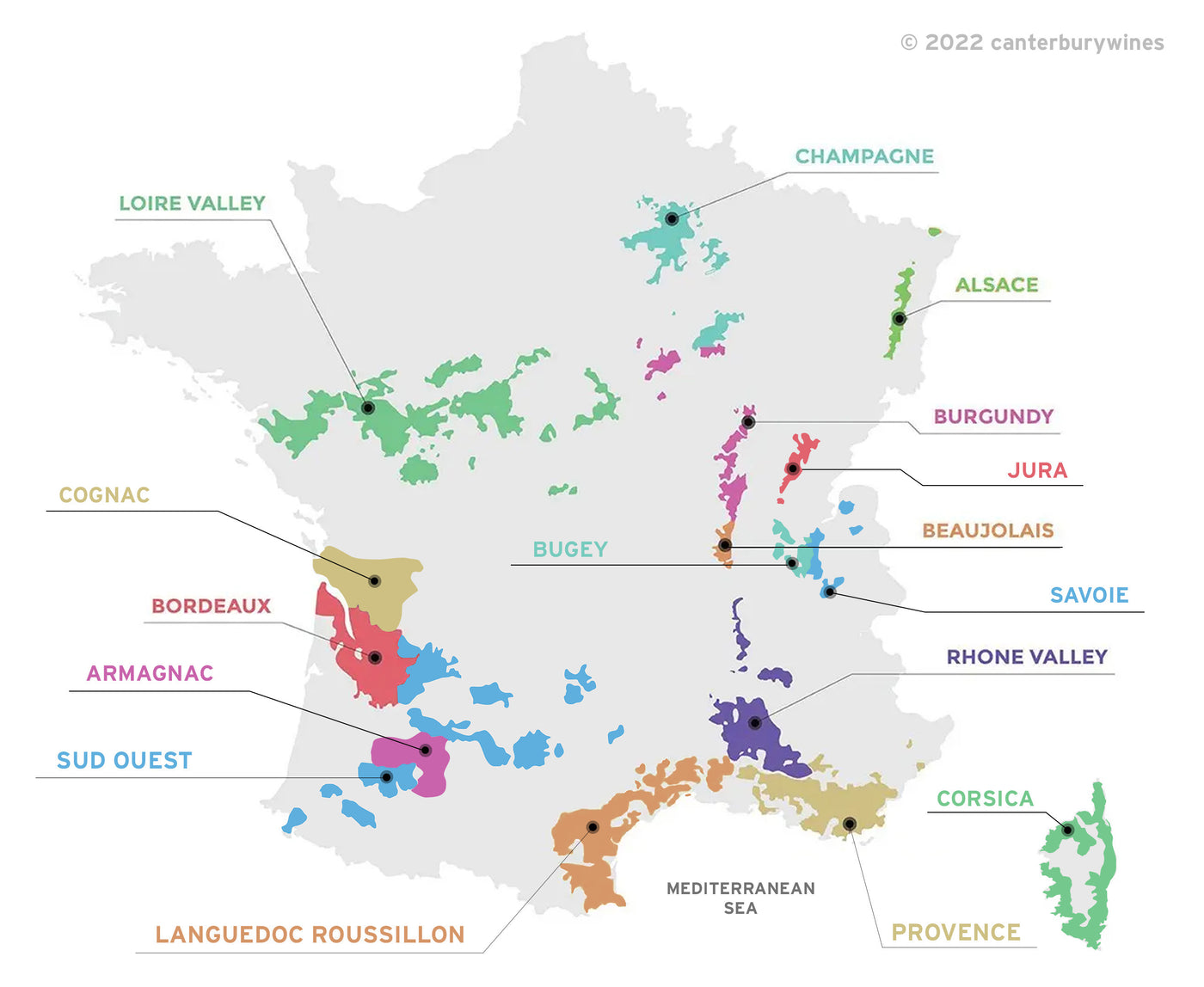
France
There are 16 major French wine regions, each known for their own unique grape varieties, terroir and wines. They are Alsace, Armagnac, Beaujolais, Bordeaux, Bugey, Burgundy, Champagne, Cognac, Corsica, Jura, Languedoc- Roussillon, Loire Valley, Provence, Savoie, South-West and the Rhône Valley.
The largest region is Languedoc- Roussillon, the oldest is Provence, the most influential and famous are Bordeaux, Burgundy, Champagne, Loire Valley and the Rhône Valley.
French wine is labelled by wine region or appellation rather than by grape variety (except in Alsace). In order to guarantee the quality and provenance of French wines, the French government established the Appellation d'origine contrôlée (AOC) system. Under this system the wine label indicates the geographical origin, quality and, generally, the style of a wine. Many regions are home to multiple appellations; for example, the prestigious Bordeaux region in the southwest of France has over 60 growing appellations.

